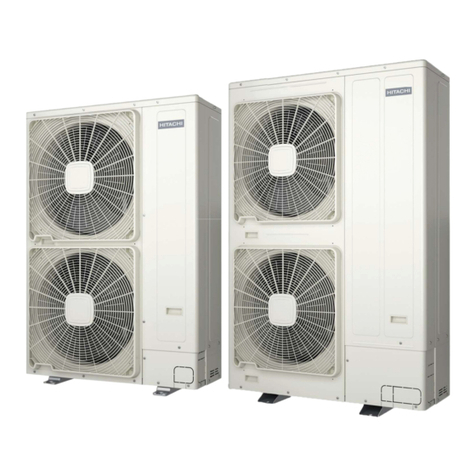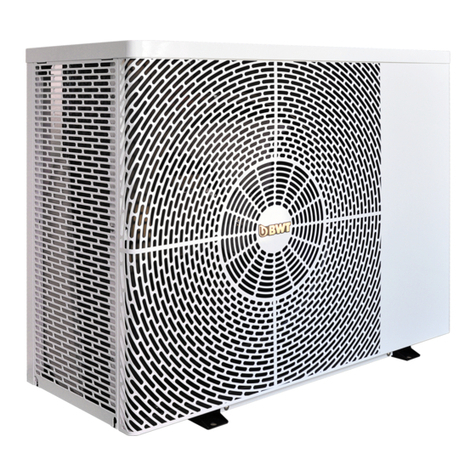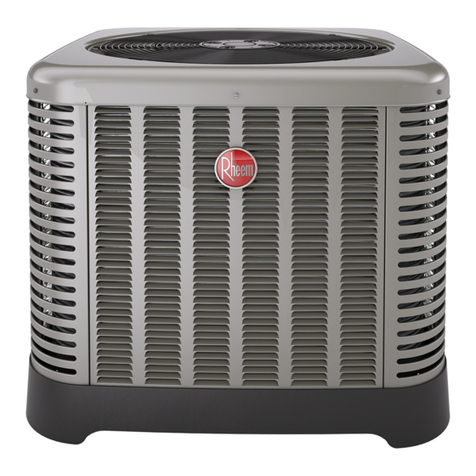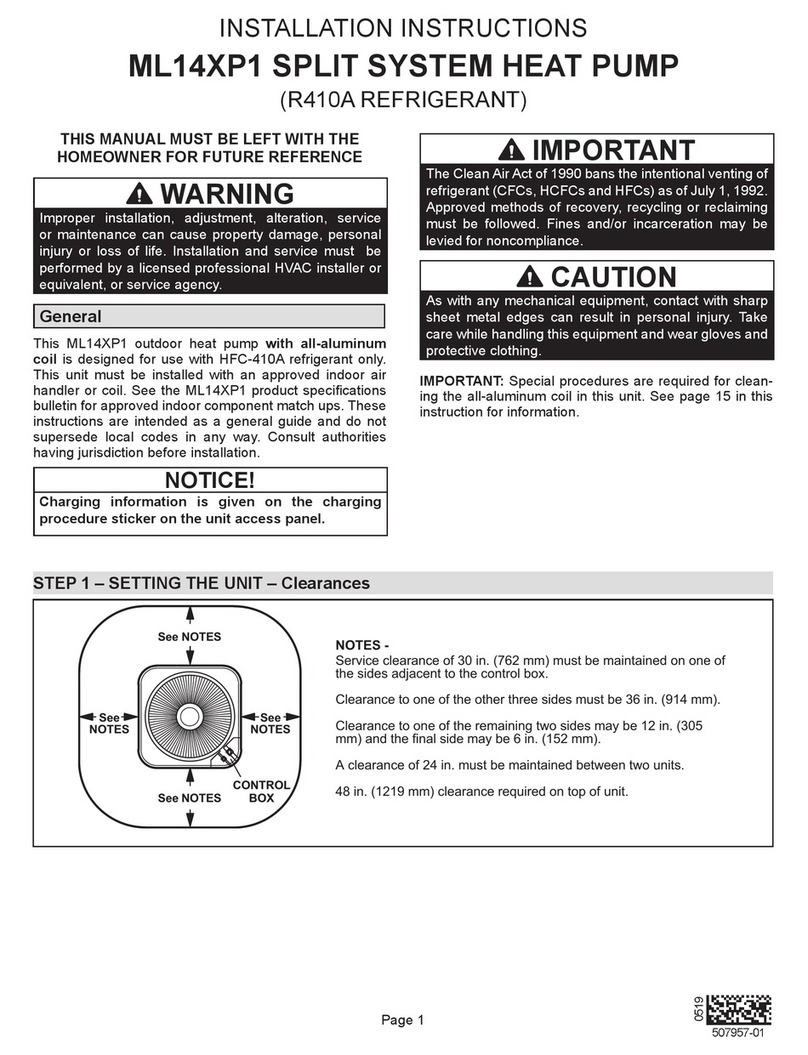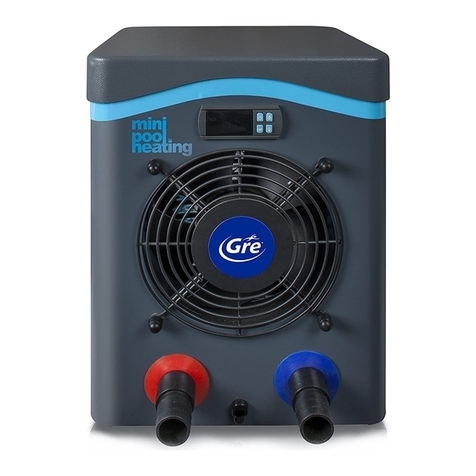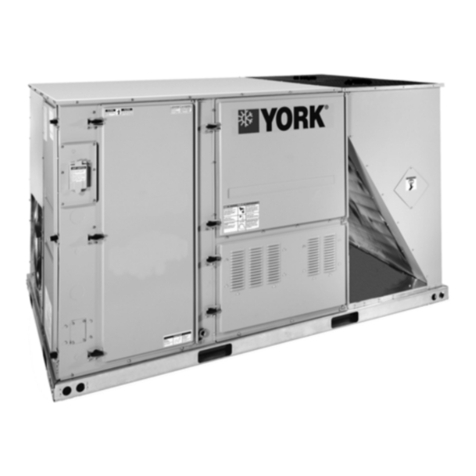Temspec VHW Series Manual

Operation & Maintenance Manual
VHW Geothermal/Water Source
Heat Pump
Form SC-OM-MANUAL ©2005 Temspec Incorporated
IMPORTANT: Read and save this manual for future reference.
This manual is to be left with the equipment owner

Table of Contents
INTRODUCTION
About the Water Source/Geothermal Heat Pump ..............................................................1
Nomenclature for Heat Pumps...........................................................................................1
TYPICAL UNIT LAYOUT
Model VHW 36/48/60 (ducted)...........................................................................................2
OPERATION
Sequence of Operation ..................................................................................................... 3
Hot Water Circuit................................................................................................................4
Water Side Circuit ..............................................................................................................5
Refrigeration Circuit............................................................................................................6
Electrical Circuit .................................................................................................................7
Dampers.............................................................................................................................7
Optional 100% Economizer................................................................................................7
Optional Powered Exhaust.................................................................................................7
Filtration .............................................................................................................................7
MAINTENANCE
Servicing the Unit...............................................................................................................8
Maintenance Schedule.......................................................................................................8
Changing the Filters...........................................................................................................9
Waterside Component Maintenance..................................................................................9
Cleaning the Evaporator Coil ...........................................................................................10
Motors..............................................................................................................................10
Cleaning the Energy Recovery Wheel..............................................................................10
TROUBLESHOOTING
Basic Troubleshooting Guidelines....................................................................................11
REPLACEMENT PARTS
Limited Warranty..............................................................................................................12
Part Sales.........................................................................................................................12

INTRODUCTION
The Temspec water source/geothermal heat pump (WSHP/GHP) was designed as a
means for providing energy efficient self-contained heating, cooling and ventilation to the
classroom. Our goal is to help create an enhanced learning environment by focusing on
the following points when designing our equipment:
•TEMPERATURE & HUMIDITY CONTROL
•AIR DISTRIBUTION
•SOUND ATTENUATION
•ENERGY EFFICIENCY
By introducing the WSHP/GHP into the classroom, superior control can be obtained for
each room. Because of the unit’s ducting capabilities, an even distribution of air can be
achieved throughout the room. The WSHP/GHP is constructed with heavy guage metal
and sound absorbing insulation for optimal sound attenuation.
By applying sound engineering principles and through continuous testing, the highest
quality of performance is obtained in the heat pump.
-1-
ABOUT THE HEAT PUMP
NOMENCLATURE FOR UNIT VENTILATORS WITH GEOTHERMAL HEAT PUMPS
V
HW
Vertical Unit
HW = Heat Pump, Water Source
36
36 = 3.0 tons of cooling
48 = 4.0 tons of cooling
60 = 5.0 tons of cooling

TYPICAL LAYOUT
SA = Supply Air
VA = Ventilation Air
ECA = Economizer Air
RA = Return Air
EA = Exhaust Air
ITEM NO.
DESCRIPTION
ITEM NO.
DESCRIPTION
ITEM NO.
DESCRIPTION
1.
Supply Air Fan (s)
8.
Return Air Damper and Actuator
15.
Heat Exchanger
2.
Auxiliary Hot Water / Electric Coil
9.
Energy Recovery Damper with Actuator
16.
Scroll Compressor, R-410A
3.
Indoor Coil
10.
Energy Recovery Exhaust Air Filter
17.
Heavy Duty Return Air Grille
4.
Drain Pan
11.
Energy Recovery Enthalpy Wheel
18.
Hinged Coil / Filter Access Panel
5.
Electrical / Controls Enclosure
12.
Energy Recovery Exhaust Fan
19.
Removable Return Air Access Panel
6.
Mixed Air Filters
13.
Powered Exhaust Damper with Actuator
7.
Economizer Damper and Actuator
14.
Energy Recovery Intake Air Filter
NOTE: The component arrangement shown above may vary slightly from that in the unit supplied.
-2-
Models VHW 36, VHW 48, VHW 60 (ducted configuration)

OPERATION
The following are typical modes of operation for a classroom unit ventilator. Please refer to the manual
provided by the controls contractor for a more specific controls sequence.
1. Unoccupied Mode
During the “unoccupied heat” mode (night set-back) space temperature is maintained by a signal from the
thermostat/controller to either the modulating control valve or electric coil. The powered exhaust damper
(if applicable) and the outdoor air damper are fully closed and the return air damper is fully open. The
supply air fan operates on call for heating or cooling from the thermostat/controller.
2. Occupied Mode
The unit ventilator is switched to “occupied mode” by the thermostat/controller. In this mode a signal is
sent from the thermostat/controller to either the modulating control valve or electric coil to maintain room
temperature at set point. The outdoor air damper is held at a minimum position in the heating and
mechanical cooling modes. The supply air fan runs continuously.
3. Economizer (up to 100% outdoor air)
The first stage of cooling is the economizer mode during which all stages of heating are off. The outdoor
air and the return air dampers modulate to maintain the room temperature at the economizer set point. If
the mixed air falls to a programmed temperature (usually 52°F) the outdoor air damper will modulate
towards closed until the mixed air temperature rises again (typically to 55°F). In this free cooling mode
the ability of the unit ventilator to provide sufficient cooling is limited only by the outdoor air temperature
and the total C.F.M. rating of the unit.
4. Mechanical Cooling
The unit ventilator utilizes the self-contained refrigeration section incorporated within the unit (DX coil,
condenser coil, compressor and refrigerant expansion device). The system maintains the cooling set
point by cycling on call from the thermostat/controller. In this mode the outdoor air damper will return to
minimum position.
5. Freeze Protection
For units with a steam or hot water coil, freeze protection is usually incorporated. This can be by either a
low limit temperature control (autoreset or manual reset) or by using a supply air sensor and programming
from the controller. When a mixed air temperature is determined to be too low, then the outdoor air
damper will close and the control valve will fully open. The fan can also be shut down until the
temperature returns to normal levels. The low limit temperature control (freezestat) should be located at
the leaving air side of the heating coil.
6. Humidistat & Hot Gas Reheat (Optional for VHC series units only)
A room humidistat sensor is included in the return air stream. The humidistat has a set point of 55% R.H.
(adjustable). When the room temperature falls to the cooling set point and the humidistat set point has
not been satisfied, the hot gas reheat coil provides reheat to maintain the cooling set point in the room (to
avoid over cooling in the space). The compressor operates under this condition. When the humidity set
point is satisfied, the reheat coil is de-energized.
-3-
Typical Modes of Operation

The following are typical auxiliary hot water piping schematic for a heat pump. Please refer to the
shop drawings for a more specific layout.
Hot Water with 2-Way Control Valve
ITEM NO.
QTY
DESCRIPTION
ITEM NO.
QTY
DESCRIPTION
1.
1
Hot Water Coil
5.
1
Actuator - Modulating
2.
1
Manual Air Vent
6.
1
Balance Valve / Ball Valve / Union
3.
1
Drain Cock
7.
1
Strainer / Ball Valve / Union
4.
1
Control Valve - 2 way
Hot Water with 3-Way Control Valve
ITEM NO.
QTY
DESCRIPTION
ITEM NO.
QTY
DESCRIPTION
1.
1
Hot Water Coil
4.
1
Strainer / Ball Valve / Union
2.
1
Manual Air Vent
5.
1
Valve - 3 Way - Modulating
3.
1
Balance Valve / Ball Valve / Union
6.
1
Drain Cock
-4-
Hot Water Circuit

The following is a typical geothermal/water source heat pump waterside schematic.
ITEM NO.
QTY
DESCRIPTION
1.
1
Heat Exchanger with Bi-Directional Receiver
2.
1
Valve - 2 Way - ON/OFF
3.
1
Valve - Balance
4.
1
Strainer / Ball Valve / Union
5.
1
Circulator Pump (Optional)
-5-
Waterside Circuit

The following is typical geothermal / water source heat pump refrigeration schematic.
ITEM NO.
QTY
DESCRIPTION
ITEM NO.
QTY
DESCRIPTION
1.
1
Compressor - R410A
12.
1
Sensor - Hi Pressure - NC
2.
1
Crankcase heater
13.
1
Sensor - Low Pressure Ref - NO
3.
3
Tee - Copper
14.
1
Controller - Anti-Ice
4.
1
Valve - Reversing - 4 Way - R410A
15.
1
Coil - DX
5.
1
Coil for Reversing Valve
16.
1
Nozzle
6.
1
Heat Exchanger with Bi-Directional Receiver
17.
1
Coil - DX (Optional for Reheat)
7.
2
Valve - TX - R410A
18.
1
Swivel Tee (Optional for Reheat)
8.
2
Filter Dryer
19.
1
3 Way Valve (Optional for Reheat)
9.
2
Check Valve
20.
1
Coil for NC Solenoid Valve (Optional for Reheat)
10.
1
Sight Glass
21.
1
Tee - Copper (Optional for Reheat)
11.
5
Valve - Access
22.
1
Check Valve (Optional for Reheat)
-6-
Refrigeration Circuit

The electrical circuit in the heat pump is dependent on the controller and sequence that is
being utilized. The unit can be supplied with a 208V, 277V or 460V power supply. The unit
is equipped with an unfused service disconnect. A copy of the electrical schematic can be
found folded in a pouch inside of each geothermal/water source, located on the electrical
enclosure or supply air fan housing.
All the included damper assemblies have airfoil section extruded aluminum blades with
flexible seal blade tips and jamb seals. The damper actuator manufacturer can vary.
Please refer to the wiring schematic for the damper actuator model type and control.
100% economizer is an option feature on the water source heat pumps. This module
includes a modulating spring return damper actuator and aluminum damper assembly and
associated controls.
Internal powered exhaust is an optional feature that may be provided with the VHW series.
This feature comes with a spring return actuated aluminum damper, direct drive fan and
ECM motor. It shall operate in tandem with the outdoor air damper to be able to provide up
to 100 % power exhaust
Typically 1” disposable filters are provided in the unit. Please refer to the “shop drawings”
for specific details on filter construction and thickness for your unit. Below are the sizes
and quantity for the typical base unit and additional filters for optional modules.
Model Number Filter Size Quantity per Unit
VHW 36/48/60 18” x 25”nominal 2
Energy Recovery Module 12” x 20”nominal 2
-7-
Electrical Circuit
Dampers
100% Powered Exhaust (optional)
Filtration
100% Economizer (optional)

MAINTENANCE
Maintenance to the unit is accomplished by removing the front access panels. Typically the
panels are secured by heavy duty Phillips (star or cross shape) head screws. When
removing the access panel, loosen but do not remove the screws. Carefully store the panel
in a place where it will not get damaged. Use caution as some access panels are heavy.
CAUTION: Disconnect power at the remote circuit breaker before servicing the
unit.
The unit comes fitted with a “fan kill switch” that de-energizes the supply air fan(s) when the
filter access panel is removed / opened. This will only disconnect the power to the supply
air fans. Be sure to disconnect ALL power by turning the remote circuit breaker to the off
position.
To access the compressor and ERV sections, you must remove a secondary panels
located directly behind the return air access panel.
Interior and exterior environmental conditions will influence the required frequency of coil
cleaning and filter change operations. The following is a typical maintenance schedule for
a classroom unit ventilator.
Initial Start-Up •Change out construction filters.
•Verify that air paths are free of construction debris and that fans turn
freely
•Verify compressor rotation
•Verify outdoor air minimum position
Every 3 months •Change filters
Every 12 months •Vacuum out evaporator drain pan
•Clean strainer in the hydronic circuit (if applicable)
•Check condition of ERV desiccant wheel, clean if necessary
Every 24 months •Clean evaporator coil
•Vacuum any loose debris from unit’s interior return air section
•Inspect dampers to ensure that there is a proper seal
-8-
Servicing the Unit
Maintenance Schedule

The outdoor and indoor conditions of your area will determine the frequency of filter
changes. Temspec recommends that the filters be changed every 3 months as a rule-of-
thumb. Note that dirty filters adversely affect the overall performance of the unit.
To change the mixed air and ERV outdoor air (OA) filters, open / remove the filter access
panel by loosening the Phillips head screws, unclip the two mixed air filters and remove.
If the unit is equipped with an ERV module you can remove and replace the ERV OA filters
which is located below the mixed air filters near the back right side of the unit.
Be sure to note the airflow direction that is marked on the filter(s).
To change the ERV exhaust filter remove the return air access panel by loosening the
Philips head screws, unclip the ERV exhaust filter located on the on the ERV access panel
and replace filter noting the airflow direction on the filter.
Replace all access panels and ensure fasteners are securely fastened.
The following are the recommended steps for performing maintenance on the Hydronic
portion of the unit.
CAUTION: Disconnect power at the remote circuit breaker before servicing the
unit.
• Clean strainer, check and clean regularly. See the maintenance schedule for
suggested frequency.
CAUTION: Disconnect power before servicing the unit.
WARNING: Do NOT use condenser coil cleaning compounds on the evaporator or
hot water coils.
To clean the evaporator coil, purchase a suitable evaporator coil cleaning solution such as
those offered by NU-CALGON. Follow the manufacturer’s instructions for use.
-9-
Changing the Filters
Waterside Component Maintenance
Cleaning the Evaporator and Hot Water Coils

Note: Chlorine based or anti-fungal “pucks” or “socks” are acceptable when placed in the
evaporator drain pan.Be sure to vacuum the drain pan after the cleaning process
is complete and prior to adding the anti-fungal component.
WARNING: Do NOT use chlorine based cleaners or anti-fungal treatments on the
aluminum fins of any coil.
Temspec provides motors that are permanently lubricated. No maintenance is required.
CAUTION: Disconnect power before servicing the unit.
WARNING: Do NOT use ACID based solutions, AROMATIC solvents, STEAM OR
WATER with temperatures GREATER than 170°F.
The clean desiccant coated polymer energy recovery wheel you will require a non-acid
based (evaporator) coil cleanser or alkaline detergent.
First you must gain access to the energy recovery wheel by removing the return air and
ERV access panel by loosening the required fasteners. Once this is completed follow the
recommended steps of the wheel manufacturer AirXchange listed below.
•Remove wheel from Heat Pump
•Remove the wheel from the cassette
•Remove loose accumulated dirt by brushing the wheel face
•Wash the wheel with a non-acid based (evaporator) coil cleanser or alkaline
detergent solution. (The wheel manufacturer suggest cleaners such as KMP Acti-
Clean in a 5% solution works well)
•If the wheel is extremely dirty it may be required to soak overnight to remove all
contaminants.
•Once soaking completed, rinse the solution from the wheel until the water comes
clear.
•Allow excess water to drain and re-install cassette.
PLEASE NOTE: There may be some staining to the desiccant however this will not
adversely affect the performance.
For more information please see the manufacturers’ website
http://www.airxchange.com/resource-center-technical-notes.htm
Model: ERC 2108 with 2” cassette
-10-
Motors
Cleaning the Energy Recovery Wheel

TROUBLESHOOTING
Problem Action Required
●Supply fan not running ●Verify that the disconnect is in the “on”position
●Verify that door micro-switch “kill switch” is
completely depressed and operating correctly
●Verify that thermostat / controller is not in
unoccupied mode (night set-back)
●Check manual reset controls (electric heat, high
refrigerant pressure controls and low limit
temperature control) and ensure that they have
not been tripped.
●Check the fan relay to observe if it is energizing
and de-energizing properly
●Check that the 24V transformer is working
properly
●Ensure that the wire connections are secured
properly
●Compressor cycling on and off ● To the condenser air path. Obstructions will
cause the unit to cut-out on high head pressure.
●Check refrigerant charge. If the charge is to low,
the unit will cut-out on low pressure. The
Refrigerant type and amount is posted on the
silver CSA label located on the electrical enclosure
or fan housing.
-11-
Basic Trouble Shooting Guidelines

REPLACEMENT PARTS
TEMSPEC INCORPORATED warrants the equipment from factory defects in material or
workmanship for a period of one year.
For this warranty to be valid, the unit(s) must be installed and maintained in accordance
with the manufacturer’s printed instructions. It does not cover parts damaged by
vandalism, improper installation, maintenance or abuse.
Should any replacement parts be required within the warranty period, they will be supplied
at no charge, freight prepaid to the jobsite. The cost of labor or incidental expenses
incurred in the repair or replacement of parts does not form part of this warranty.
The warranty period commences from the date of shipment, except when otherwise agreed
at the point of sale (see specific warranty terms and conditions for details).
Contact the factory at: 1-888-TEMSPEC or (905) 670-3595
Ask for ‘parts sales’
Be sure to provide the unit serial number which is located on the metalized CSA label, on
the fan housing, inside the units.
-12-
Limited Warranty
Parts Sales
This manual suits for next models
3
Table of contents
Popular Heat Pump manuals by other brands

Samsung
Samsung Freedom MIM-E03AN Installation and maintenance manual
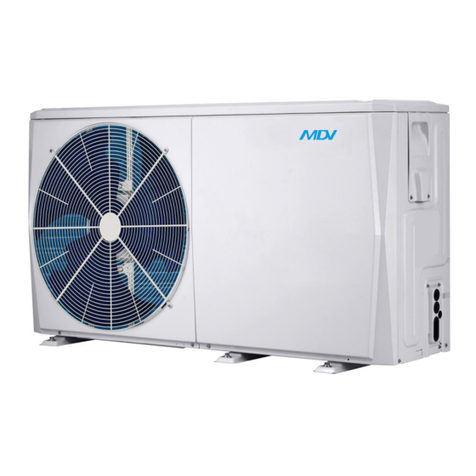
MDV
MDV IMPACT MONO AHPM V4W/D2N8-B engineering data

Carrier
Carrier CH16NA installation instructions
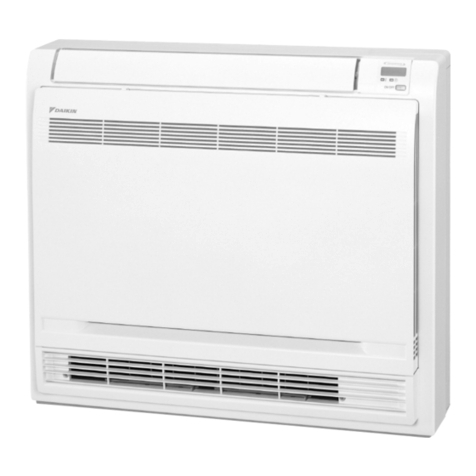
Daikin
Daikin Super Multi NX FVXS35FV1B Service manual

Racer
Racer INVERTER 7 manual
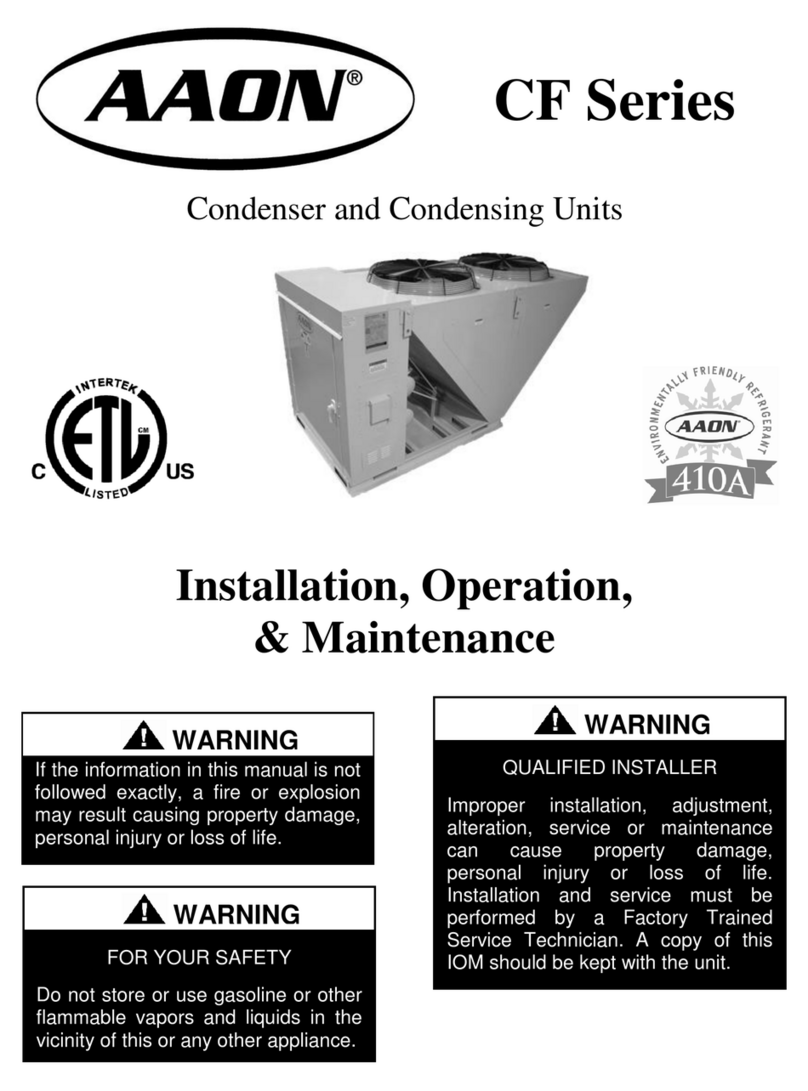
AAON
AAON CF Series Installation operation & maintenance
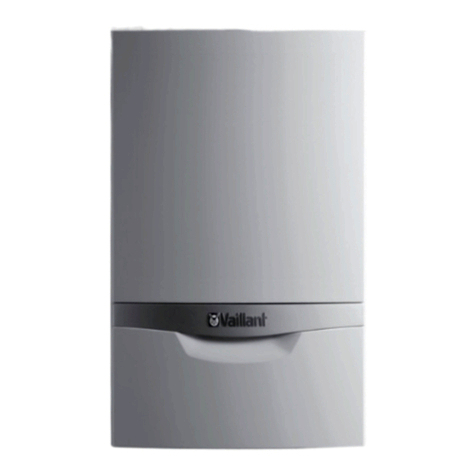
Vaillant
Vaillant geoTHERM Installation and maintenance instructions

Trane
Trane 4TTR3 Installation and operation manual

Haier
Haier GE NS22HM installation instructions

Amana
Amana PTH073J35A Installation instructions & owner's manual

MHP
MHP HPX SERIES Installation guide & owner's manual
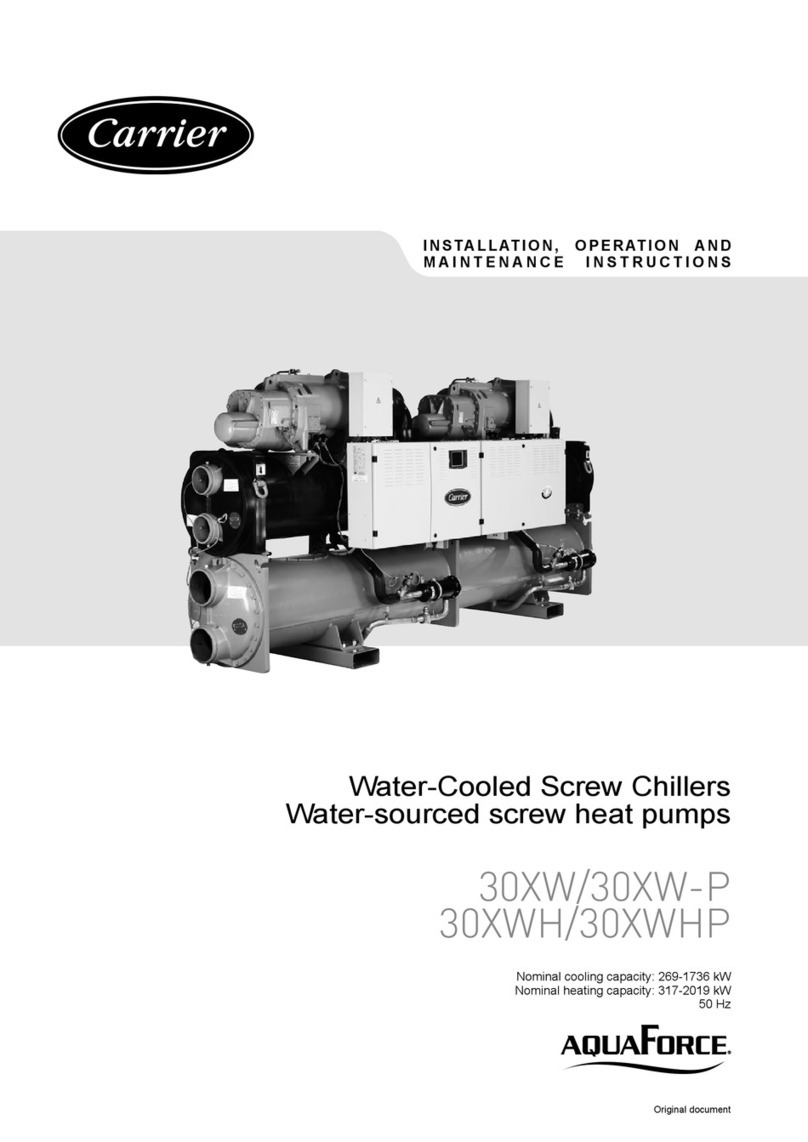
Carrier
Carrier 30XW Installation, operation and maintenance instructions
